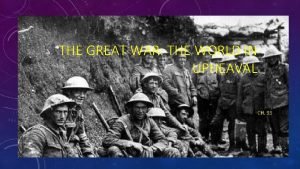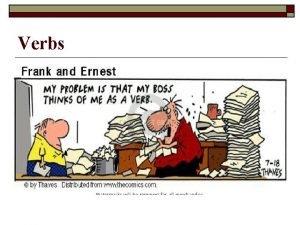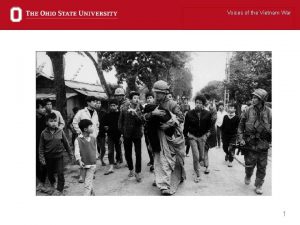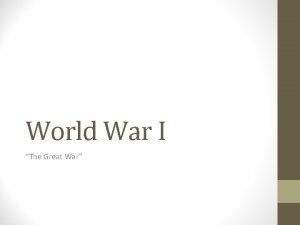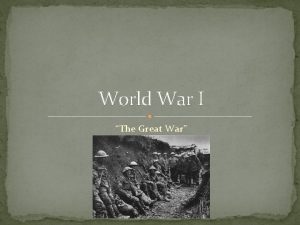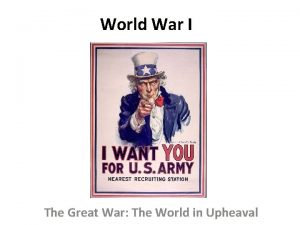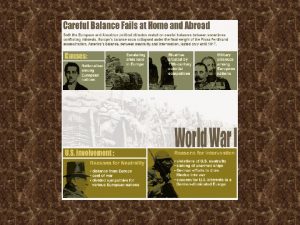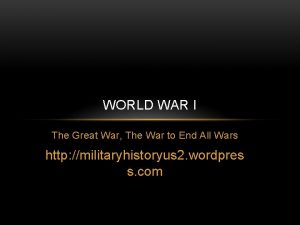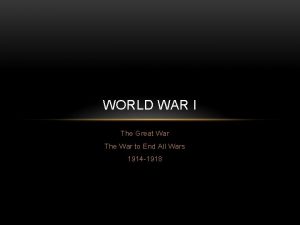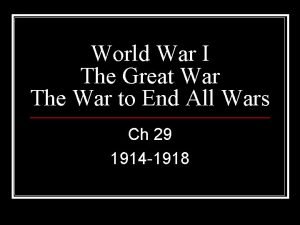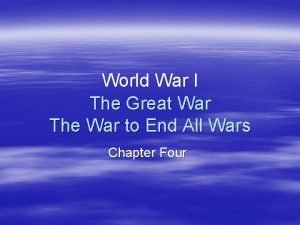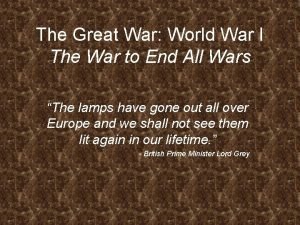WORLD WAR I Voices of the Great War



















- Slides: 19

WORLD WAR I Voices of the Great War

FIRST HAND PERSPECTIVE “ At every moment we are sprayed with clouds of earth and stone splinters. How many men are afraid. How many men are weak at the knees!. . . we are no longer in a civilized world. One suffers and says nothing. At our feet the wounded groan in a pool of blood. For hours these groans and supplications continue until they die right in front of our eyes with no one able to help them. ” -Henri Desagneaux, A French Soldier’s War Diary 1914 -1918

AN AUDIO PERSPECTIVE http: //www. youtube. com/watch? v=5 HXv 3 AVbprg

WHAT IS TRENCH WARFARE?

EXAMPLE OF TRENCH WARFARE

TRENCHES: SYMBOL OF THE STALEMATE • By the end of the war, each side had dug at least 12, 000 miles of trenches • French occupied the majority of trenches • The Allies in WWI included: France, Italy, Russia (main three). • Allies had 4 types of trenches

TYPES OF TRENCHES 1) Front line or “firing line”- located 50 yards to 1 mile from the German front line trench 2) Support trench, located behind the front line and contained men and supplies to help 3) Reserve trench, more men and supplies in case the first line should be overrun 4) Communication trenches, connecting everything, for relaying messages. Sometimes, underground.

TRENCH NETWORK

THE GERMANS • Germans constructed much better and more elaborate trenches and tunnels than did the Allies • Some of their trenches went more than 50 feet below the surface • Allies only had ‘open air’ trenches • Germans included beds, toilets, and electricity into their trenches. • Trench life was much better for the Germans, less suffering

TRENCH SETUP

A WAR OF MOVEMENT? • Instead of being short, the war lasted longer, and moved LESS than anticipated. • Years of stalemate, from 1914 to 1918 • War began with Germans quickly moving through Belgium and France, but quickly got stuck with the beginning of the trench warfare method • Let’s have a look at what trench life was like…

DAILY DEATHS • Nearly constant shells falling was the biggest cause of death • New or young soldiers would often die because of the urge to look over the edge of the trench or parapet • Snipers were a great danger as well • 1/3 of the deaths in WWI came from the trenches • However, much of the death came from disease

RAT INFESTATION • Millions of rats, the size of cats brought disease along with them • It was a huge problem because they contaminated the food • Men would often swear that the rats could sense when gunfire was about to happen because the would run and hide

STAND TO AND THE MORNING HATE • Each morning, before dawn, both sides would gather at the front of their trenches to stand guard against a possible dawn attack • Many attacks were still carried out at this time • To relieve tension, both sides would let loose machine gun fire and heavy shell directly at the other • Most dangerous hour of the day. Why?

RUM RIFLES AND BREAKFAST TRUCE • First thing every day: Cleaning of the rifles • Both sides agreed that no one would attack during the breakfast hour every morning • When officers learned of these ‘truces’, they would quickly end them. However, they persisted throughout the war.

PATROLLING NO MAN’S LAND • Checking and repairing barbed wire, others would go out to ‘listening posts’ to try and listen for valuable information • Sometimes, enemy groups would meet while out patrolling No Man’s Land. They would usually hurry away from each other • Firing guns while out in the open was dangerous. It would attract machine gun fire.

NO MANS LAND BARBED WIRE

LONE PATROL

WAS IT WORTH IT? Now discuss, on paper, your OWN opinion on trench warfare. What was the point? Movie: joyeux nöel http: //www. youtube. com/watch? v=KRrr-CDXijs That was uplifting, right?
 Many voices one world
Many voices one world The great war: the world in upheaval
The great war: the world in upheaval Poems for two voices
Poems for two voices Men's voices ireland
Men's voices ireland The dust bowl images
The dust bowl images Hark ten thousand voices crying
Hark ten thousand voices crying пассивный залог
пассивный залог 5 voices nurturer guardian
5 voices nurturer guardian Hark ten thousand voices crying
Hark ten thousand voices crying Hark ten thousand voices crying
Hark ten thousand voices crying Young voices toronto
Young voices toronto Chapter 9 voices and instrument families
Chapter 9 voices and instrument families Hope for the silent voices
Hope for the silent voices Faces and voices of recovery uk
Faces and voices of recovery uk Have you heard the sound of the angels voices
Have you heard the sound of the angels voices Youth voices
Youth voices Realistic fantasy genre
Realistic fantasy genre Transitive verbs have _____ voices.
Transitive verbs have _____ voices. Hình ảnh bộ gõ cơ thể búng tay
Hình ảnh bộ gõ cơ thể búng tay Lp html
Lp html

